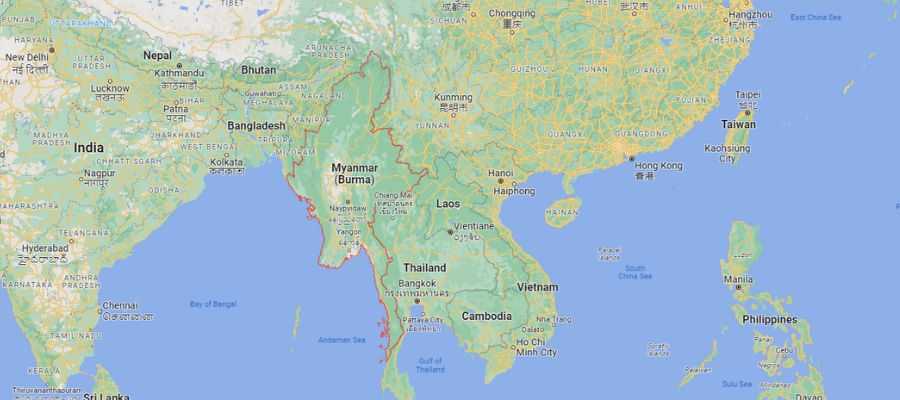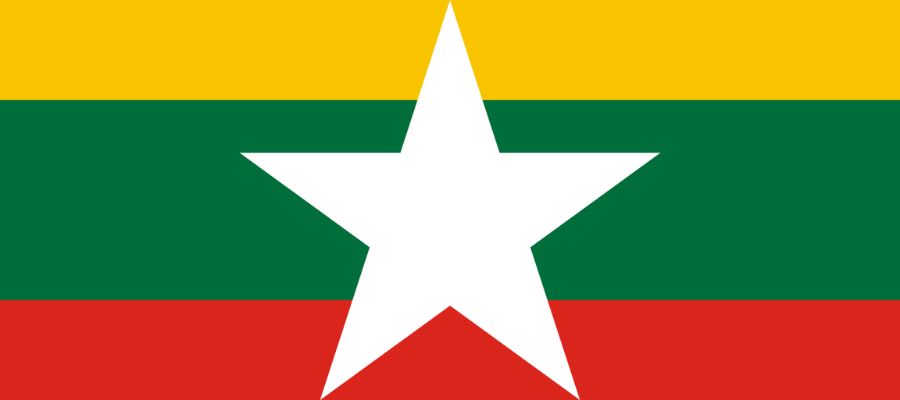One challenge that Speech-Language Pathologists face when asked to conduct a speech-language evaluation on a bilingual speaker or someone who speaks a language other than English is understanding whether their speech and language patterns are typical or whether they are indicative of a speech disorder or language disorder. There are a number of Chin speakers in the Pacific Northwest and throughout the United States. Knowledge of the speech sounds that exist in Chin, the rules for how those sounds can be combined, and the Chin speech and language structures will help us to be able to make better decisions about whether Chin speakers we evaluate have speech and language disorders or whether their patterns are typical for Chin-English bilingual language development.
Conflict and violence in Myanmar (Burma) have led many people from that region to the United States. As children from Myanmar enter the United States school system, they bring with them their native tongue and begin learning English in school. For speech-language pathologists, it is important for us to understand the Chin speech sounds and Chin language features in order to better understand expected patterns that may be used by native Chin speakers as they develop proficiency in the English language.
According to Ethnomed, the majority of Chin refugees entering the United States have limited education and are between the ages of 20-40, many with young children. There is a sizeable population of Chin people in the Seattle area.
In this post, we will share information about the Chin language spoken by those from Myanmar. It is also called Hakha Chin or Lai. In a separate post we will share information about Karen. There are many Karenic languages. We gathered information about the Karenic language spoken by most people, which is S’gaw Karen.

Where is the Chin language spoken?
Chin is spoken in western Myanmar (Burma) in the Chin State, as well as northeastern India and southeastern Bangladesh. Chin is spoken by roughly half a million people.
What language family does Chin originate from? It is a language that stems from the Sino-Tibetan language family. Both the Latin script and Burmese script are used for the written language.
Are there different dialects of the Chin language? There are approximately 40-45 dialects of the Chin language. The most commonly spoken are Tedim, Hakha, Falam, and Mindat Cho. Some linguists consider these to be different languages rather than dialects.
Customary Greetings and Nonverbal Interactions for Chin speakers
- The Chin people often greet each other with a gentle handshake.
- Direct eye contact can be viewed as a challenge and impolite.
- Most Chin do not look each other directly in the eyes when speaking to one another.
- According to the Center for Applied Linguistics (2007), there is a high degree of respect for elders. Signs of respect include bending at the waist and crossing both arms over the chest. Sitting at a lower level than elders is also a sign of respect. Pointing feet towards anyone is a sign of disrespect.
- It is common for children to be quiet when in the presence of elders. This is a sign of respect.

Chin Speech and Language Development
Chin Consonant Phonemes in Comparison to English
Below are tables that show the consonant and vowel phonemes of Chin as they compare to English. The top row includes sounds unique to Chin. The middle row includes sounds shared by English and Chin. Note that three of the sounds exist in both languages but, in Chin, are produced with slight dentalization, unlike in English. The bottom row includes sounds unique to English.
| Chin Consonants Not Shared with English | /m̥/ /n̥/ /ŋ̊/ /ʈ/ /ʔ/ /pʰ/ /tʰ/ /ʈʰ/ /kʰ/ /t͡s/ /t͡sʰ/ /tɬ/ /tɬʰ/ /l̥/ /ʀ/ /ʀ̥/ |
| Chin Consonants Shared With English | /p/ /b/ /t/ /k/ /f/ /v/ /h/ /m/ /n/ /ŋ/ /j/ /l/ /g/ (rare) | /d/ /s/ /z/ (slightly dentalized) |
| English Consonants Not Shared with Chin | /ʃ/ /ʒ/ /t͡ʃ/ /d͡ʒ/ /l/ /ð/ /θ/ /ɹ/ /w/ |
Chin Vowel Phonemes in Comparison to English
The vowel sounds of Chin all exist in English. There are no vowel sounds in Chin that do not exist in English but there are many English vowel sounds that do not exist in Chin. The result of this for a Chin-speaker learning English is that they may substitute a vowel from their vowel repertoire when they encounter an unfamiliar vowel sound in English. This is a typical pattern that can be understood as Chin-influenced English. It is not indicative of a speech disorder. Also note that the five vowel sounds of Chin can be produced as short sounds or long sounds but the length of the vowel sound does not differentiate meaning. The long and short vowels are allophones in this case rather than phonemes.
| Chin Vowels Not Shared with English | |
| Chin Vowels Shared With English | /ɑ/ /e/ /i/ /o/ /u/ (may be produced as long or short vowels in Chin but the length does not differentiate meaning) |
| English Vowels Not Shared with Chin | /ɚ/ /ɔ/ /ɛ/ /ʌ/ /ʊ/ /ɪ/ /æ/ /ə/ |
Phonology in the Chin Language
Below are some phonotactic constraints, or sound rules, of the Chin language.
- Words are primarily monosyllabic but there are some multisyllabic words that have been borrowed from other languages.
- Chin is a tonal language. Syllables can be rising, falling or low tone.
- Hakha Chin has voiced and voiceless consonants like English but also has aspirated consonants that differentiate meaning. For example, there are three bilabial plosives, p, b, and pʰ.
- The parent language of Chin, Proto-Chin, included [g] (voiced velar plosive) but it was eventually lost from the language. There are a number of borrowed words used in Chin that include [g] but it is rare.
Chin Language Features
- Chin has a Subject-Object-Verb (SOV) sentence structure. An example of this is, “I ball throw.” Subject-Verb and Object Verb are also acceptable structures.
- Negation follows the verb in Chin, unlike in English. Thus a structure such as, “I ball throw not” or “I go not” would be acceptable.
- Plurality is marked by adding a suffix. There are a number of different suffixes that can be used to mark plurals. Thus, when learning English, the practice of adding a suffix to mark plurality will not be a new concept.
- Possession is indicated by syntax and not morphology (‘s), as in English.
- There are no definite articles in Chin.
- There are no indefinite articles in Chin.
- Adjectives follow nouns. For example, the description “pillow orange” would be an expected pattern for a Chin speaker in the process of learning English.
- Quantity is also marked after the the noun (e.g. pillows three) instead of prior to the nouns (e.g. three pillows), as is typical in English.
The Chin Family of Languages
The Chin language is one of a group of languages spoken in Myanmar (formerly Burma). Other languages in the family include Naga, Lai, and Hakha Chin. For the purposes of this post we focus on Chin but have included paragraphs with details about each of these languages and some of their shared elements and distinct features.
Naga Language
The Naga people live in the northwestern part of Myanmar, India, and parts of Nepal. They speak several Naga languages that are characterized by their complexity and diversity. There are numerous dialects that are often not mutually intelligible. In other words, speakers of different dialects often cannot understand one another.
Lai Language
The Lai language, also known as Lai Hakha or Hmawng, is spoken by the Lai people in parts of western Myanmar and northeastern India. Lai is closely related to the Chin languages and shares similarities in grammar and vocabulary. However, its script and pronunciation is unique to Chin in many instances.
Hakha Chin Language
Hakha Chin is one of the Chin languages spoken in the northern regions of Myanmar. It has a unique script, known as Hakha Lai, which is based on the Roman alphabet. Burmese has strongly influenced Hakha Chin but the Hakha Chin language retains some linguistic features that are distinct from Burmese, including tone markers that affect the meaning of words.
For more information about the process of evaluating speech and language skills in bilinguals, get a copy of Difference or Disorder: Understanding Speech and Language Development in Culturally and Linguistically Diverse Students. It is available in paperback and ebook versions.
For more information about Chin speech sound and Chin language features, see the World Atlas of Language Structures Online.
The Open Language Archives also has valuable information about the Chin language.



